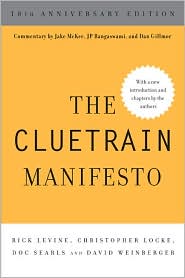Hierarchy and Collaboration in the
Hierarchy and Collaboration in the Globe
Back-to-back articles in the Boston Globe talk about the present hierarchical assumptions of business and the future of collaboration.
DC Denison pins his story on hierarchy on the intelligence failure that culminated on 9/11. He quotes Philip Evans, author of Blown to Bits, who says information hierarchies used to work because information itself was manageable.
The solution, according to Evans, is to create a system that allows for multiple, overlapping points where information can be sorted and analyzed. ”If we get better at sharing information across organizations,” he says, ”we’ll get better at processing an abundance of information effectively.”
The problem with information hierarchies isn’t that some people have more authority than others, it’s that the information flow is one-way and codified. In a non-hierarchical, web-based system, authority figures emerge, but they’re only as respected as their work entitles them to be. This is how it works with the columnists you choose to read … except now anyone can be a columnist even without being anointed as such. That’s why blogging seems like a transformative business tool to many of us.
Scott Kirsner‘s article today talks about the present and future of collaborative software, a category that has not taken off with the rapidity with which it deserves. Many of the major players are in the Boston area. including eRoom, SiteScape, Lotus and Groove Networks. But Redmond, and its $51M investment in Groove, looms over the region and the article.
Here’s the essential problem for the industry. Kirsner writes:
Simon Hayward at Gartner points out that the business world may take a bit longer before it embraces collaboration software as it has embraced e-mail. ”The technology can do a lot of great things, but the limiting factor is organizations’ interest in using it,” he says.
Yet Kirsner’s article is clear that the benefits of using collaboration software are multiple and manifest. You don’t need to be a rocket scientist, although maybe you do since Lockheed Martin is the article’s lead example of a company using the stuff. So, why aren’t organizations more interested in using it?
One explanation: We are in the realm not of scientifical business management but organized religion. The issue isn’t business efficiency but the maintenance of power. Collaboration software does indeed hyperlink the hierarchy. And that’s just plain scary to The Establishment, the status quo and/or The Man. The price of admission is business’ corrupt soul.
(Notes: 1. The Globe’s window for free access to these columns is only a week or so. 2. Denison quotes me.)
Categories: Uncategorized dw









